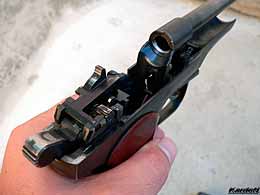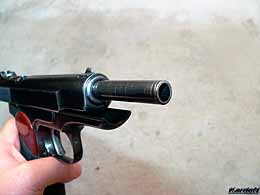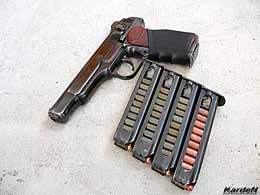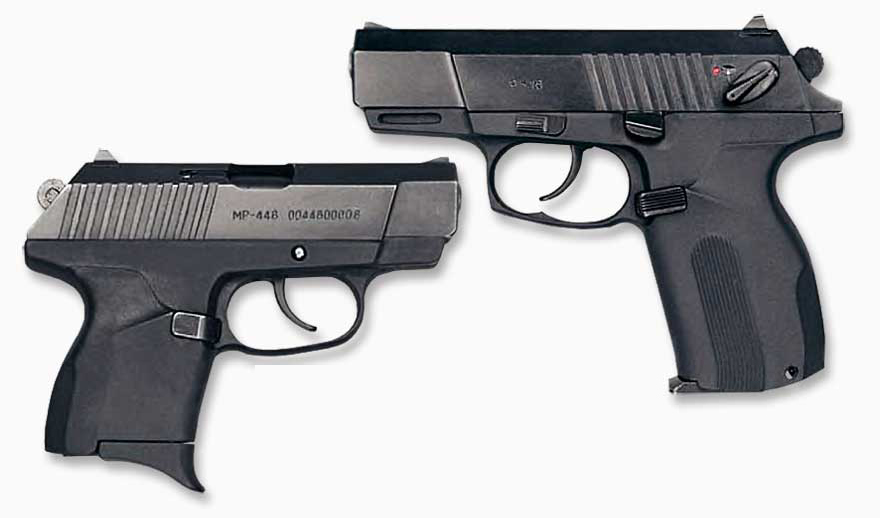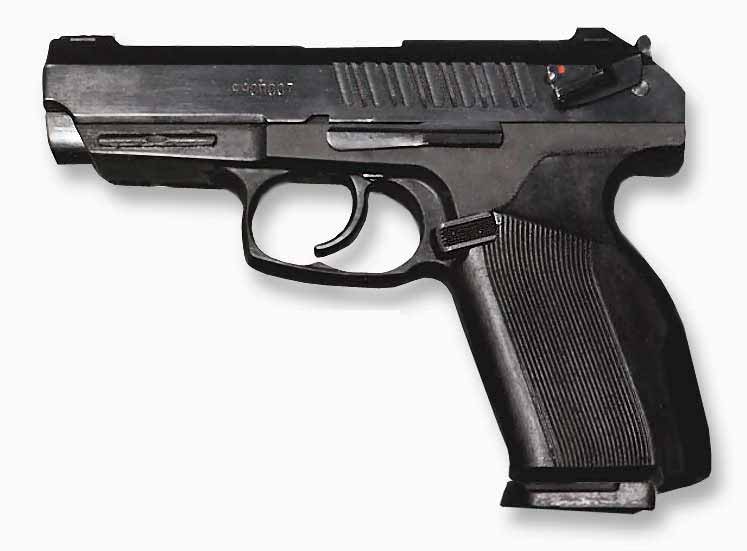 APS Stechkin automatic pistol
APS Stechkin automatic pistol
Russia has made repeated attempts to develop an automatic pistol capable of conducting both single-shot and full automatic fire. WWII demonstrated that there is a niche for small-size automatic weapons. The niche could be occupied by an automatic pistol or a small-size submachine gun. However, the USSR ceased the development of submachine guns almost completely after the Great Patriotic War and resumed this work much later In the Sate 1940s armorers started designing automatic pistols for equipping officers and other ranks of certain qualifications. Just like self-loading pistols, the new automatic pistol was designed to fire the new 9 mm pistol cartridge. The automatic pistol tender saw participation of P. V. Voevodin, I. Ya. Stechkin (then working for the TsKB-14 Central Design Bureau), and M. T. Kalashnskov. The 9 mm Stechkin APS automatic pistol entered service with the Soviet Army simultaneously with the РУ self-loading pistol in 1951.
The pistol is a blowback-operated weapon. The barrel is pressed into the frame and secured by a lock pin. The slide wraps around the barrel. The recoil spring is wound around the barrel. When the slide moves to the rear, it extracts the spent cartridge case from the chamber by a spring-loaded extractor, whose tooth presses the cartridge case to the bolthead recess. The cartridge case hits the cartridge ejector and is extracted through the ejection port. The pistol is fitted with an external-hammer trigger assembly. The trigger and fining mechanism comprises a pivoting hammer, a sear with a spring, a disconnector with a spring, a trigger with a spring, a trigger bar and a cylindrical spiral hammer spring with a strut. The firing pin is mounted inside the slide. The hammer has a cocked position and a half-cock. The pistol can operate in the single-action and the double-action modes. The trigger is pulled with a warning. The manual safety lever also acts as a fire selector lever. It has the following three positions: ‘safe’, ‘single shots’, and “automatic fire’. The pistol grip accommodates a rate reducer. The rate reducer creates the required delayed blowback for burst fire by reducing the slide recoil and delaying disconnection of the sear and the sear notch. The reduced rate of fire improves the stability of the weapon, firing bursts.
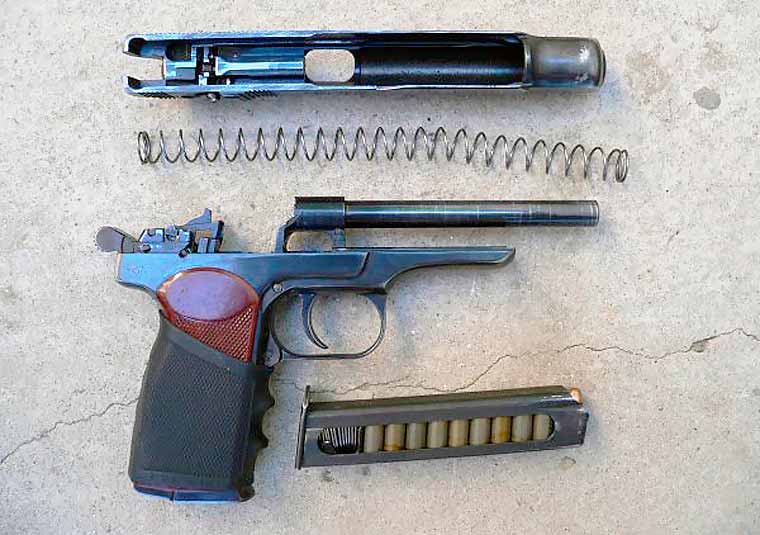 APS Stechkin automatic pistol
APS Stechkin automatic pistol
When the fire selector/safety fever is set to single-shot fire, it presses the plunger and the rate reducer down so that the tooth of the Salter doesn’t engage the trigger bar. Then when the selector lever and the slide move to the rear, the plunger and the rate reducer are lifted until they rest against the slide slot, and when the slide completes its backward motion and starts moving forward the rate reducer drops down. The rate reducer, lifted by its own spring, rotates the plunger until it rests against the selector lever and stops without lifting the trigger bar. To fire the next shot it is necessary to release the trigger first. It will return to its home position, while the trigger bar will move back and up and the disconnector, forced by its spring, will a8so rise and engage the sear notch. When the trigger is pulled the mechanism will repeat its cycle. When the fire selector/safety lever is set to automatic fire, it allows the plunger and the rate reducer to go all the way up. The tooth of the rate reducer engages and lifts the trigger bar. This way when the slide moves both backward and forward it hits the tooth of the plunger, which forces the rate reducer down, taking off some of the recoil energy and slowing the slide down. When the slide move forward the notches of the slide and the selector lever assume a position, which allow the plunger and the rate reducer to go at the way up,. When the rate reducer returns upwards under the action of its spring, its side tooth hits the trigger bar. The trigger bar rises, simultaneously lifting the disconnector. The side tooth of the disconnector rotates the middle tongue of the sear, and disconnects it from the sear notch, although the trigger has not been pressed yet The pistol fires the next shot. In other words the rate reducer also acts as an automatic trigger. When the selector lever rotates forward, the safety catch moves lo the rear and blocks the firing pin, the hammer, and the slide {locks the slide and the frame together).
When the magazine is empty, the magazine follower tooth lifts the slide stop and the slide remains to the rear. When the empty magazine is replaced with a loaded one, It is necessary to press the slide stop latch The slide will be pulled forward by the recoil spring and will chamber the next round, while the hammer will remain in the cocked position, and the pistol will be ready to fire again.
The slide carries a foresight and a ramp-type rear sight. The sight is adjusted by rotating the adjustment drum which presses on a spring-loaded rear sight leaf (a cam mechanism). The rear sight can be adjusted to a range of fire of 25, 50, 100 and 200 m.
The detachable box-type chequerwise 20-cartridge magazine is flush with the pistol grip. The separate grip plates are screwed to the frame.
A wooden (and later on plastic) rigid holster stock comprises a body, a rigid cover, and a nose-piece with a latch. The pistol is fixed inside the holster by the spring, mounted on the internal side of the cover. The button latch of the cover and the open position of the pistol grip reduce the time needed to unholster the pistol. The holster is carried on a sling over the shoulder white four magazines are carried in a special pouch.
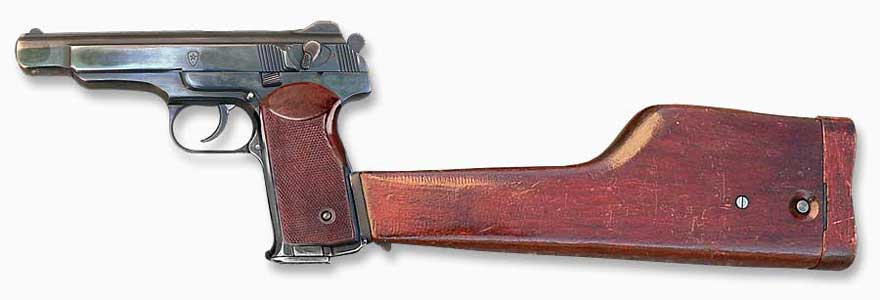
A 140 mm long (15 5 caliber) barrel has partially made up for the weak cartridge, and combined with the heavier weight (as compared with that of the Makarov PM pistol) and smoother operation of the firing mechanism, resulted in a better accuracy of fire. The bullet dispersion of the APS firing single shots at a range of 50 m is 5 cm, and at a range of 200 m it equals 22 cm. However, fire at ranges of up to 50 m turned out to be most efficient.
The Stechksn APS pistol had been in production at the Molot Machine-Building Plant, Vyatskie Poiyany between 1952 and 1959. The pistol entered service with pilots, combat vehicle crews, sailors, grenade launcher and gun crews. Generally, the APS pistol features quite a successful design. The fact that the APS and the PM pistols had a number of common design features and the similar assembly/disassembly procedure made the Stechkin pistol easy to master. However, due to the inconveniences of carrying the APS like its considerable weight, rigid holster (which caught edges of the hatch when a shooter left a combat vehicle) and others, the APS was withdrawn from the inventory and production. Nevertheless, the APS was literally resurrected during the war in Afghanistan, when Special Forces units started using both the APS and its silenced APB version. The pistol then attracted attention of other categories of customers Grenade launcher crews sometime used the APS instead of assault rifles. Later on the APS pistol became popular also with the Russian Ministry of Interior.
Specifications APS
Caliber: 9 mm
Cartridge: 9×18 PM
Weight w/o cartridges: 1.02 kg
Weight w/holster stock: 1.78 kg
Pistol length: 225 m
Length w/holster stock: 540 mm
Length of barrel: 140 mm
Bullet muzzle velocity: 340 m/sec
Effective rate of fire: 40/90 rds/min
Sighting range: 200 m
Magazine capacity: 20 rds
Photo review Stechkin automatic pistol – APS

